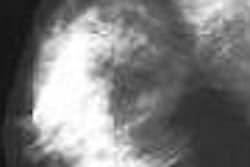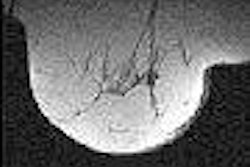Mammography services across the U.S. are being challenged by staffing shortages that can only worsen as more women reach screening age. Meanwhile, at one East Coast institution, biopsy rates are on the rise.
A 2002 analysis by the U.S. General Accounting Office determined that the country's mammography services were at an adequate capacity to meet the needs of an aging population. But that conclusion was based on data that are now five years old and no longer represent the mammography screening landscape. Indeed, if current trends continue, the early detection of breast cancer could be hampered by a lack of resources to meet the demand, according to a national survey.
A second in-house study done at the University of Pittsburgh found an increase in biopsy rates without any corresponding increase in cancer detection.
High demand, low resources
To assess the current realities of delivering mammography services, Dr. Carl D'Orsi and colleagues queried staff at three breast cancer surveillance programs: the Colorado Mammography Advocacy Program, the New Hampshire Mammography Network, and the Group Health Cooperative Breast Cancer Surveillance System in the Pacific Northwest. Centers in these programs were community- and academic-based, as well as for-profit and not-for-profit.
"This multicenter study utilized a unique collaboration among three geographically and clinically distinct breast cancer surveillance programs," wrote D'Orsi and colleagues. "Thus, they represent a broad spectrum of mammography facilities in the United States" (Radiology, May 2005, Vol. 235:2, pp.391-395).
D'Orsi is director of the Breast Imaging Center at Emory University in Atlanta. His co-authors are from multiple institutions in Chicago; Seattle; Hanover and Lebanon, NH; and Birmingham, AL.
A nine-page, 15-minute survey was sent to 53 centers in these programs. Forty-five centers responded, for an 85% response rate. The majority of surveys (75%) were completed by the lead mammography technologist. Questions were asked about staffing levels, annual volume of screening and diagnostic exams, and appointment wait times.
Of these 45 centers, only 20% provided screening mammography alone without diagnostic services. The bulk of centers (76%) offered diagnostic exams, while others also performed breast ultrasound (67%), breast MR (16%), full-field digital mammography (11%), and cyst aspiration (53%). Seventy-three percent of the centers were located in urban areas.
Not surprisingly, nearly half (44%) of the 45 facilities reported radiologist staffing shortages; not-for-profit and/or community facilities bore the brunt of the deficiency.
Twenty percent of the centers stated they had unfilled RT positions. "Of note is that almost half of all facilities (47%) reported some level of difficulty maintaining adequate MQSA-qualified technologists," the authors wrote. "Perhaps MQSA's strict certification requirements ... many of which are educational, occur on weekends, and often are not tied to better pay ... have become a disincentive."
In terms of appointments, for-profit facilities had shorter mean wait times for screening mammography (12.5 days) versus not-for-profit (14.7 days). There was a less of a difference for diagnostic exams, 3.4 days versus 4.9.
"Our results indicated a possible trend toward increasing waiting time for both screening and diagnostic mammography at sites with larger mammographic volume," D'Orsi's group wrote.
They hypothesized that the reasons for the manpower shortage were a lack of interest in breast imaging among radiology residents, rampant malpractice litigation, stringent MQSA standards, and for RTs in particular, a decrease in the number of women entering the field.
While one weakness of this study was potential inaccuracies in self-reported data, the authors stressed that the results are still distressing. As the need for breast imaging services grows, and the number of qualified interpreters dwindles, "more mammograms may be interpreted by an increasingly stressed discipline of mammographic interpreters, which would result in a decline in interpretive acumen," they warned.
In an e-mail interview with AuntMinnie.com, D'Orsi stated that the advent of new technology -- computer-aided detection (CAD), full-field digital mammography -- may alleviate some hardships, but will ultimately add to the workload of an overburdened staff.
"Digital technology will increase technologist throughput since the image can be critiqued by the technologist in six to 10 seconds, versus three to four minutes with film processing," D'Orsi explained. "However, it will not positively impact on reading time, and as a matter of fact, initially for the readers, it may actually increase the time. CAD, if used correctly (i.e., only after the mammogram has been examined by the radiologist), may also increase reading time."
Unfortunately, given what D'Orsi described as the "insidious ... lack of respect for radiologists dedicated to breast imaging," convincing residents to become those readers will continue to be an uphill battle.
Burgeoning biopsy
When it comes to recommending follow-up biopsies, U.S. breast health specialists tend to err on the side of caution -- more than 1 million breast biopsies are performed every year, and about 80% of the findings turn out to be benign.
"Biopsy of 'too few' suspicious findings will decrease the number of breast cancers detected.... Conversely, biopsy of 'too many' negative or benign findings is expensive financially and emotionally, without a corresponding gain in cancer detection," wrote Dr. David Gur and colleagues from the University of Pittsburgh Medical Center and Magee-Womens Hospital, also in Pittsburgh (Radiology, May 2005, Vol. 235:2, pp.396-401).
Gur's group retrospectively evaluated recall and biopsy rates for their group of academic, mammographic readers over a 27-month period. Screening mammograms from Magee-Womens Hospital and five satellite clinics were reviewed, all of which had been interpreted by 21 MQSA-qualified radiologists with three to 32 years of experience.
Recall cases consisted of those that required further evaluation, those that had palpable findings during clinical breast exam, and recalls due to the lack of previous films. Recommendations for recall for technical difficulties were excluded.
Of the nearly 100,000 screening exams performed at the six centers, 11.55% were recalled. The overall rate of biopsies was 16.76 per 1,000 exams. Over the 27-month period, recall rates ranged from 10.59% to 12.35%; biopsy rates started at 22.8%, climbed slightly to 25.9%, and dipped to 18.9% before increasing by 5.9%.
"We found no significant trend for recall rate during the study period.... However, the increasing trend for biopsy rate was significant ... with a substantial fraction of the increase being attributed to stereotactic vacuum-assisted core biopsies," the authors stated. "This possible 'chasing' of the subtle microcalcification may vary substantially among radiologists."
Another reason for the upswing in biopsy rates was the introduction of CAD into their practice, the authors suggested. "CAD is highly sensitive in the detection of subtle microcalcifications, and its routine use may have lowered the threshold ... for recommending further evaluation."
In an e-mail interview with AuntMinnie.com, Gur commented on the potential impact of reader experience, although this issue was not formally assessed in the study.
"The numbers and distribution of detected cases by observer type ('experience') are such that large differences must exist in order to be able to identify meaningful trends in this relatively small study, which we did not," Gur wrote. "This does not mean that these trends do not actually exist. We are continuing to assess this issue, but we believe -- unsupported statistically by data to date -- that individual reading 'style' (e.g., generally being more or less 'conservative') is possibly more important in this case than years of experience (or lifetime total volume read)."
In addition, Gur stated that his group will evaluate annual reading rates or the volume of reads done by an individual in a year.
The results of this study did not bring substantial changes at Gur's institution, but he noted that his group is using it as a basis for quality assurance reviews that may ultimately bring pratice changes.
Gur stressed that these results are specific to one practice; generalizing the data would require a larger data pool.
"At this time we do not have plans to initiate a multi-institutional study, but we are continuing to evaluate several practice-related issues (similar to the ones presented in this paper) in the hope of highlighting those areas, if any, that warrant a careful assessment," he explained. "We hope that discussing these enable us to gradually get better at what we do."
By Shalmali Pal
AuntMinnie.com staff writer
May 6, 2005
Related Reading
Studies decipher mammo trends, explore ways to alleviate patient distress, February 2, 2005
Breast biopsy costs big bucks, but so does cancer screening, January 19, 2005
Copyright © 2005 AuntMinnie.com



















